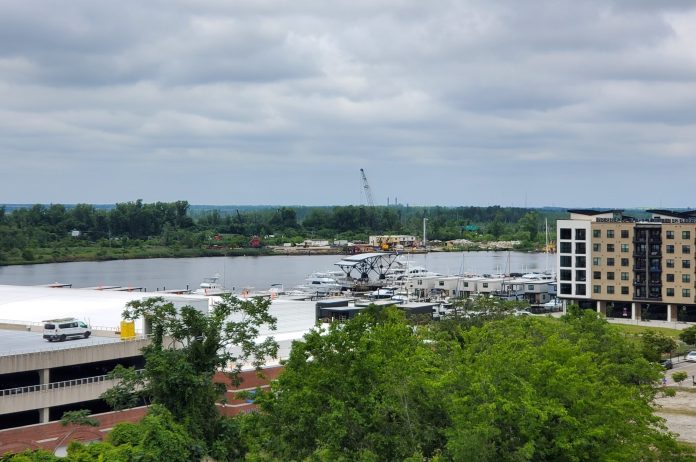Urban canopy is tree cover seen from above; Wilmington’s canopy makes up 41% of the city limits. (Port City Daily/Amy Passaretti Willis)
WILMINGTON — Over the past four years, Wilmington has lost 16% of its tree canopy — primarily due to natural disasters and development.
READ MORE: City considering waiving building fees to incentivize affordable housing
The city’s first-ever tree canopy regulation, care and preservation plan was presented to City Council on Tuesday and offers some positives for the community’s tree protection, as well as some tips on what the city could do better.
The Urban Forestry Master Plan – developed by the Davey Resource Group over 18 months with input from the city’s Community Services Department – captures the city’s tree population. It also assigns value to plantings and makes recommendations to improve future strategies.
The city awarded DRG a $139,600 contract in August 2021 to conduct research aimed at prioritizing tree care, taking an inventory, and educating the public about enhancing and protecting tree populations. The plan will be an integral part of the city’s forest department, which is tasked with managing the city’s tree system.
The DRG estimates that there are 32,500 trees across the city, 92% of which are in good or fair condition.
It also showed that the top five species – crape myrtle, laurel oak, live oak, dogwood and willow oak – accounted for 58% of the total tree cover.
Locally, crape myrtle accounts for 28%, laurel oak for 14%, live oak for 8%, and dogwood and willow oak for 5% and 3%, respectively.
A general rule of thumb for urban forestry, explained Joe Joyner, Associate Project Manager at DRG, is that no species should account for more than 10% of the total tree population. All trees that are publicly and privately owned within the city limits are considered urban forests.
Councilor Charlie Rivenbark asked why the 10% rule is important.
“If you have a monoculture and, for example, an invasive insect, particularly Wilmington as a port city, you may lose a significant portion of your canopy in that event alone,” Joyner told the council.
In terms of daily tree loss, Joyner said removing a single large mature tree per tree had the greatest impact on canopy loss as well as the Forest Service’s budget. To replace lost trees, the city, in collaboration with partner organizations, has planted 873 trees and distributed 9,164 trees and seedlings since 2020.
“Throughout the process, I and my colleagues have been impressed by the great interest and passion that citizens, stakeholders and officials have shown for trees,” Joyner told the council.
A survey published between May and July 2022 returned 1,537 responses.
Key Findings: 94% totally agree trees are important to Wilmington and 96% agree they are worth the financial cost of maintaining them. However, 93% also stated that there were too few trees in the city.
In fact, the city’s tree coverage—branches, trunks, and leaves covering the ground when viewed from above—is 41.4% in 2020, which is in line with the average for nationwide communities of similar size and scope. Comparable examples are Atlanta, Charlotte, Savannah and Annapolis; although Charleston, South Carolina is well above this with a canopy of 60%.
DRG reported its inventory that 10,126 trees and 323 stumps lie within Wilmington’s 1945 corporate boundaries—from the Cape River River east to Wallace Park and the Martin Luther King Jr. Parkway south to Greenfield Lake.
More than 10,000 trees provide environmental benefits including removing 5,980 pounds of air pollutants and particulate matter, absorbing 88 tons of carbon and capturing 1.3 million gallons of rainwater.
The DRG deputy project manager explained that the key benefits of a healthy urban tree canopy are reducing and filtering rainwater, improving air quality, providing habitat for wildlife, mitigating the local climate, reducing energy costs, increasing property value and to improve the aesthetics and character of the city.
The city’s forest budget for fiscal 2022 was $1.13 million. Spending was $34.77 per street tree, 35% less than the average for all US cities.
Wilmington has a backlog of 904 requests for tree care services – assessments, pruning, removal, stump grinders as of January 2023. The city saw a surge in services in fiscal 2020 as more residents stayed home and more frequently recognized the need for trees.
The city conducts the majority of its tree care in-house, with seven employees for every employee tending 4,643 trees. Willmington ranks just below the city’s statewide average of 4,821 trees per employee.
The main work order is tree pruning with 89% of its duties being 8% dedicated to tree felling and 3% to stump crushing. Additional roles could help with the request backlog; Nine positions are planned for the coming year.
The 11 recommendations of the master plan include:
- Complete the inventory of all public trees in Wilmington
- Update the city’s urban canopy rating
- Establish a proactive urban tree management program
- Develop and strengthen relationships and partnerships to support the implementation of the city’s Forestry Master Plan
- Ensure city regulations, best management practices and policies are in place to support tree growth and maintenance
- Focus on planting and nurturing trees in locations that advance the city’s equity and sustainability goals and priorities
- Develop and implement a public engagement, outreach, and education plan
- Provide staff to support city forest operations
- Create and implement an environmental threat monitoring and response program for the Wilmington urban forest
- Improve communication, collaboration and coordination between city departments and external agencies
- Develop a wood waste management strategy and determine the highest and best use of wood from trees removed from the city
The City Council will vote on a resolution to approve the City Forestry Master Plan at a future meeting.
Tips or Comments? Email amy@localdailymedia.com.
Want to read more from PCD? Subscribe now and then subscribe to our morning newsletter Wilmington Wire and get the headlines in your inbox every morning.
portcitydaily.com
https://portcitydaily.com/latest-news/2023/06/10/the-city-has-30k-trees-and-wants-to-regulate-its-canopy-to-protect-future-loss/











